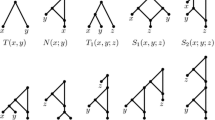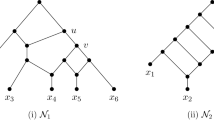Abstract
While every rooted binary phylogenetic tree is determined by its set of displayed rooted triples, such a result does not hold for an arbitrary rooted binary phylogenetic network. In particular, there exist two non-isomorphic rooted binary temporal normal networks that display the same set of rooted triples. Moreover, without any structural constraint on the rooted phylogenetic networks under consideration, similarly negative results have also been established for binets and trinets which are rooted subnetworks on two and three leaves, respectively. Hence, in general, piecing together a rooted phylogenetic network from such a set of small building blocks appears insurmountable. In contrast to these results, in this paper, we show that a rooted binary normal network is determined by its sets of displayed caterpillars (particular type of subtrees) on three and four leaves. The proof is constructive and realises a polynomial-time algorithm that takes the sets of caterpillars on three and four leaves displayed by a rooted binary normal network and, up to isomorphism, reconstructs this network.






Similar content being viewed by others
References
Aho AV, Sagiv Y, Szymanski TG, Ullman JD (1981) Inferring a tree from lowest common ancestors with an application to the optimization of relational expressions. SIAM J Comput 10:405–421
Bickner DR (2012) On normal networks. Ph.D. thesis, Iowa State University, Ames, Iowa
Bininda-Emonds ORP (2004) The evolution of supertrees. Trends Ecol Evol 19:315–322
Bordewich M, Semple C (2016) Determining phylogenetic networks from inter-taxa distances. J Math Biol 73:283–303
Bordewich M, Huber KT, Moulton V, Semple C (2018) Recovering normal networks from shortest inter-taxa distance information. J Math Biol 77:571–594
Bulteau L, Weller M (2019) Parameterized algorithms in bioinformatics: an overview. Algorithms 12:256
Cardona G, Rosselló F, Valiente G (2009) Comparison of tree-child phylogenetic networks. IEEE/ACM Trans Comput Biol Bioinf 6:552–569
Francis A, Moulton V (2018) Identifiability of tree-child phylogenetic networks under a probabilistic recombination-mutation model of evolution. J Theor Biol 446:160–167
Francis AR, Steel M (2015) Which phylogenetic networks are merely trees with additional arcs? Syst Biol 64:768–777
Gambette P, Huber KT (2012) On encodings of phylogenetic networks of bounded level. J Math Biol 65:157–180
Habib M, To TH (2012) Constructing a minimum phylogenetic network from a dense triplet set. J Bioinform Comput Biol 10:1250013
Huber KT, Moulton V (2012) Encoding and constructing 1-nested phylogenetic networks with trinets. Algorithmica 66:714–738
Huber KT, van Iersel L, Moulton V, Wu T (2015) How much information is needed to infer reticulate evolutionary histories? Syst Biol 64:102–111
Huber KT, van Iersel L, Moulton V, Scornavacca C, Wu T (2017) Reconstructing phylogenetic level-1 networks from nondense binet and trinet sets. Algorithmica 77:173–200
van Iersel L, Kelk S (2011) Constructing the simplest possible phylogenetic network from triplets. Algorithmica 60:207–235
van Iersel L, Moulton V (2014) Trinets encode tree-child and level-2 phylogenetic networks. J Math Biol 68:1707–1729
van Iersel L, Moulton V, de Swart E, Wu T (2017) Binets: fundamental building blocks for phylogenetic networks. Bull Math Biol 79:1135–1154
Jansson J, Sung WK (2006) Inferring a level-1 phylogenetic network from a dense set of rooted triplets. Theoret Comput Sci 363:60–68
Jansson J, Nguyen NB, Sung WK (2006) Algorithms for combining rooted triplets into a galled phylogenetic network. SIAM J Comput 35:1098–1121
McDiarmid C, Semple C, Welsh D (2015) Counting phylogenetic networks. Ann Comb 19:205–224
Murakami Y, van Iersel L, Janssen R, Jones M, Moulton V (2019) Reconstructing tree-child networks from reticulate-edge-deleted subnetworks. Bull Math Biol 81:3823–3863
Pardi F, Scornavacca C (2015) Reconstructible phylogenetic networks: do not distinguish the indistinguishable. PLoS Comput Biol 11:e1004135
Semple C, Steel M (2003) Phylogenetics. Oxford University Press, New York
Willson SJ (2010) Properties of normal phylogenetic networks. Bull Math Biol 72:340–358
Willson SJ (2011) Regular networks can be uniquely constructed from their trees. IEEE/ACM Trans Comput Biol Bioinf 8:785–796
Acknowledgements
We thank the two anonymous referees for their constructive comments.
Author information
Authors and Affiliations
Corresponding author
Additional information
Publisher's Note
Springer Nature remains neutral with regard to jurisdictional claims in published maps and institutional affiliations.
The authors were supported by the New Zealand Marsden Fund.
Rights and permissions
About this article
Cite this article
Linz, S., Semple, C. Caterpillars on three and four leaves are sufficient to reconstruct binary normal networks. J. Math. Biol. 81, 961–980 (2020). https://doi.org/10.1007/s00285-020-01533-7
Received:
Revised:
Published:
Issue Date:
DOI: https://doi.org/10.1007/s00285-020-01533-7




